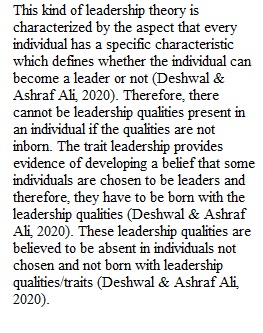


Q Assignment Content 1. Resources: Leadership Theories Grading Guide As a leader, you often need to display or clarify a concept. A matrix is a grid that contains information and offers a visual model of ideas. For this assignment, you will create a matrix that explains leadership theories. Research the following five leadership theories, and include these in your matrix. Use the provided Leadership Theories Matrix: o Trait theories of leadership o Behavioral theories of leadership o Contingency models of leadership o Skills approaches to leadership o Situational methods of leadership Develop the definition and characteristics of various leadership theories and approaches to leadership (trait leadership, behavioral leadership, contingency leadership, skills leadership, and situational leadership). Provide one or more examples to support the definition or characteristics of each form of leadership. Write out your explanations in each section using about 350 words for each section. Format your Leadership Theory Matrix with the template and consistent with APA guidelines. Submit your assignment. Resources: o Center for Writing Excellence o Reference and Citation Generator o Grammar and Writing Guides
View Related Questions